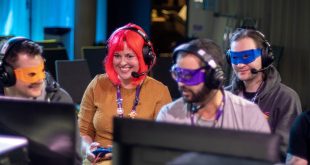 As the lead programmer on the seminal Command & Conquer and the founder and creative director of Westwood successor Petroglyph Games, Joe Bostic knows a thing or two about RTS games. Richie Shoemaker interrogates him on the most recent.
As the lead programmer on the seminal Command & Conquer and the founder and creative director of Westwood successor Petroglyph Games, Joe Bostic knows a thing or two about RTS games. Richie Shoemaker interrogates him on the most recent.
While World War I has provided fertile terrain for literature, film and satirical musical theatre, it’s been a veritable no man’s land for games over the decades. Sure, there has been a steady stream of multiplayer FPSs in recent years, but it wasn’t really until EA and DICE went over the top with Battlefield 1 in 2016 that the first of them put its head above the parapet. On the strategy game front, there have been a few hardcore releases for the grognard elite, but more mainstream real-time strategy franchises and developers have exclusively focused on theatres and timelines where armies haven’t been stuck in the same place for years with no end to the digital carnage in sight.
It took Petroglyph Games to break the deadlock, with it’s quietly celebrated RTS The Great War: The Western Front, which was published by Frontier Foundry earlier this year. The game, developed by the studio that succeeded the great Westwood, manages to convey the bloodshed without being bloody, the interminable grind without being tedious or grindy, and offers innovative ways for players to advance in a conflict not known for anything but grim stalemate.
FPS developers have successfully adapted WWI in recent years. Did you think it was time for an RTS dev to do the same?
Doing an RTS game set in WWI’s Western Front poses many challenges and that might explain why the RTS genre has been previously underserved in this setting. Trenches and the historically static front line make the traditional tropes of RTS gameplay difficult, but in The Great War: Western Front we wanted to highlight how trench warfare really redefined strategic thinking at the time, and how for players it changes how they approach our game.
Was it a difficult game to pitch? How did Frontier become involved?
The game wasn’t a difficult pitch, we felt the idea of a WWI RTS was something that hadn’t been explored previously. When we got talking with Frontier, and the opportunity arose to work with the Imperial War Museums’, it seemed like a perfect fit to ground the game in real history.
It’s probably not something you’ve faced before, but how difficult was it to get the tone of the game right, given the nature of the conflict and how it’s perceived – especially in the context of there being a similar bloody stalemate in Europe right now?
Ongoing present-day conflicts are something that we’re very mindful of in our presentation of past warfare. Our focus with The Great War: Western Front is not to glorify or romanticise the battlefield, but to create a historically authentic WW1 strategy experience in which players are asked to make difficult choices, exploring how their decisions can (and do) have wider consequences.

Gamers like to noticeably advance in their RTS games, which is not a phenomenon WWI was known for. How did you approach solving that issue and are happy with your solution?
Although the theatre front line moved relatively slowly during The Great War, on the battlefield where the map covers a small area, the “front” moves quite a bit. A successful offence would push the enemy completely out of the battlefield. In the grand scheme of things, this would need to be repeated several times in order to move the theatre front line enough miles to register as capturing a region hex. This is the nature of WWI western front combat – there were very few strategic “breakouts” where advancement was rapid and unopposed over many miles. By combining the theatre and battlefield experiences in The Great War: Western Front, the player experiences both the slow-moving nature that the war was known for but also pushing the enemy off the battlefield map.
Were there any unexpected challenges you faced during development?
Incorporating trenches in a genre that is dominated by open field warfare. The strategy and tactics with trenches are quite different than fighting in the open, the trick is to get the game systems and the computer A.I. to effectively work together in a cohesive battlefield.
Looking back, are there any decisions you would have made differently?
We’re proud of how we’ve created a unique strategy experience which authentically explores one of the most pivotal moments in modern history, and as a team we’re always looking at how to refine our gameplay to support players’ ambitions. Our passionate community have shared a wealth of feedback with us and one area we’re looking forward to exploring with them more in an upcoming update, is modding support. At Petroglyph, we’ve always had fantastic backing from the modding community and we’re delighted to extend that to The Great War: Western Front.
Can you envisage revisiting WWI? Not necessarily for a sequel, but are there elements you think can be represented differently or more effectively?
World War I was a very diverse war. The warfare on the Eastern Front was quite different from static trench lines of western Europe. There is the naval warfare aspect – not just Jutland, but the use of submarines. Fighting in Africa and the Middle East was completely different as well. Each of those theatres are rich for exploration in the gaming space.

Similarly, is there a Petroglyph (or Westwood) game or IP that you’d love to return to?
Right now, our focus is firmly on The Great War: Western Front. Of course, we’re regularly receiving requests to revisit our previous games, and some of those continue to see regular modding development even now. We’re looking forward to seeing the modding community exploring the framework of The Great War: Western Front in the coming months.
It’s been 20 years since Westwood was dissolved. How much of its DNA remains within Petroglyph and how would you say Petroglyph has evolved in the years it formed?
About half of the staff are former Westwood Studios people so much of the DNA is the same. Petrolgyph is a much smaller company than Electronic Arts so the strategic operation of the studio is more like an Indie studio rather than a branch of a large gaming company. Petroglyph has been around, I think, longer than
Westwood managed to be, but players still link the studio to Westwood. Does that frustrate you?
Not at all. Westwood was a great place to work at and the people were top notch. Being associated with Westwood, even tangentially, is an honour. Although Command & Conquer was created in what seems like a different world than today’s development environment, we still keep the same passion for game development that we first had.

 MCV/DEVELOP News, events, research and jobs from the games industry
MCV/DEVELOP News, events, research and jobs from the games industry




